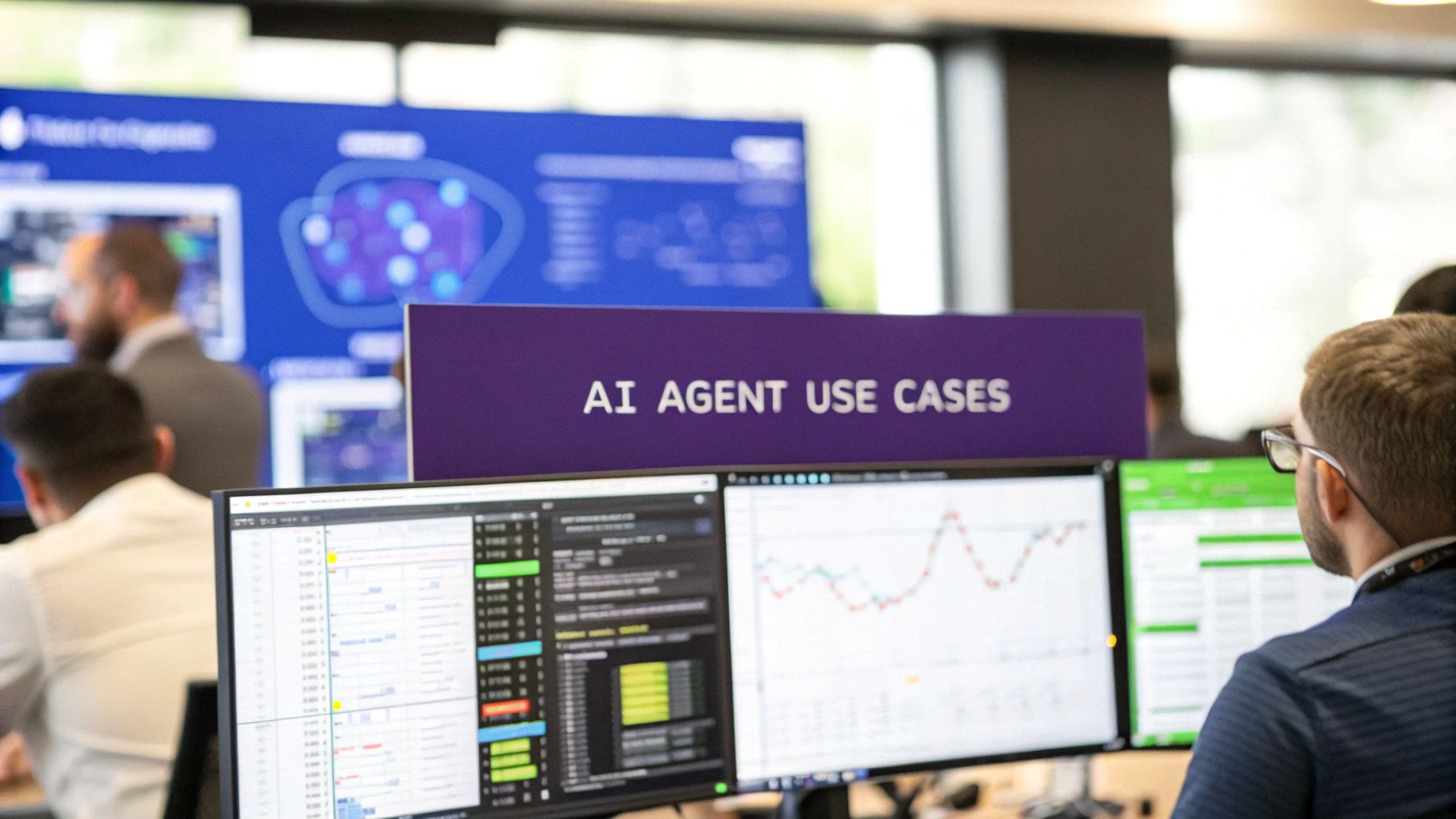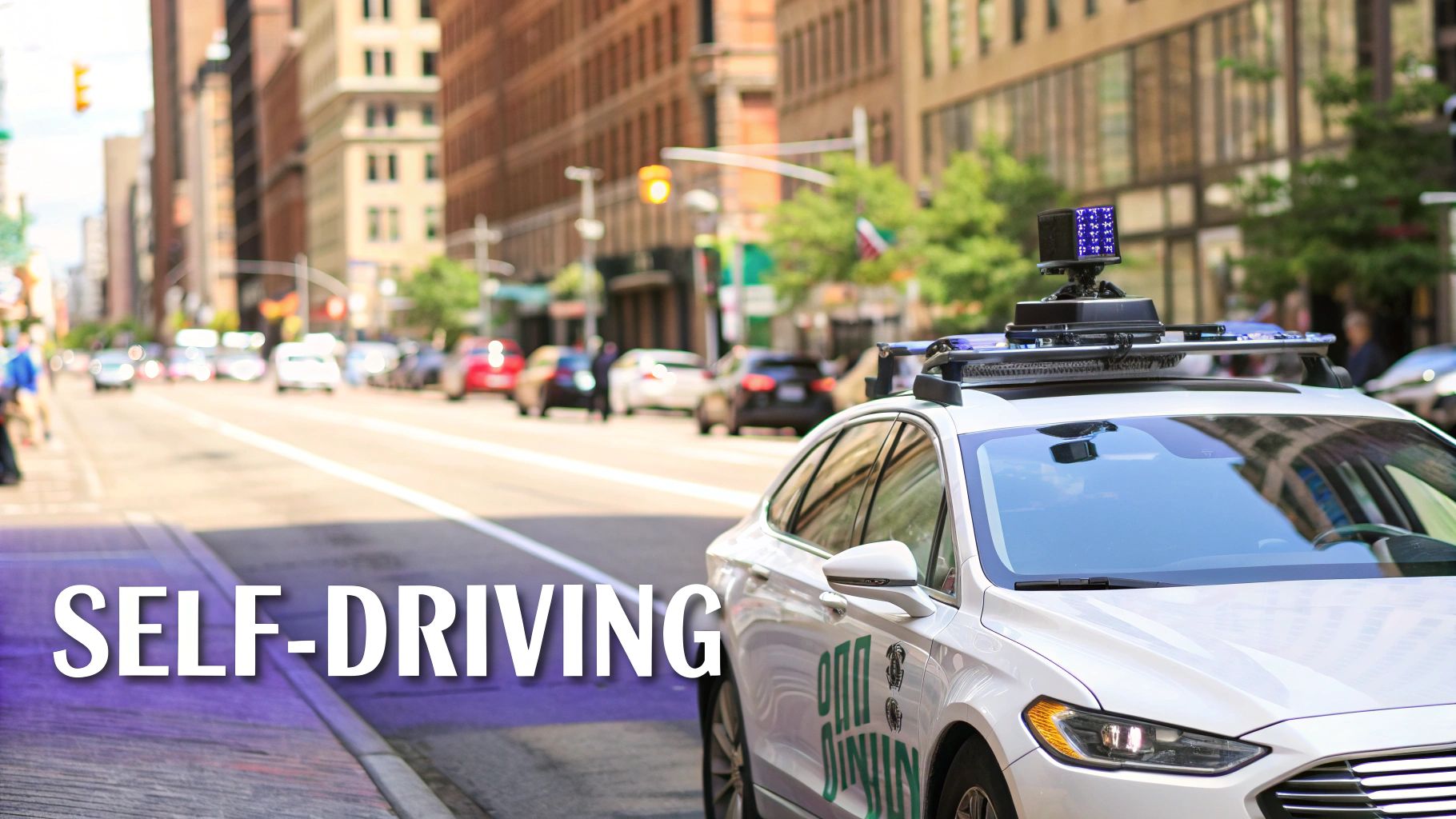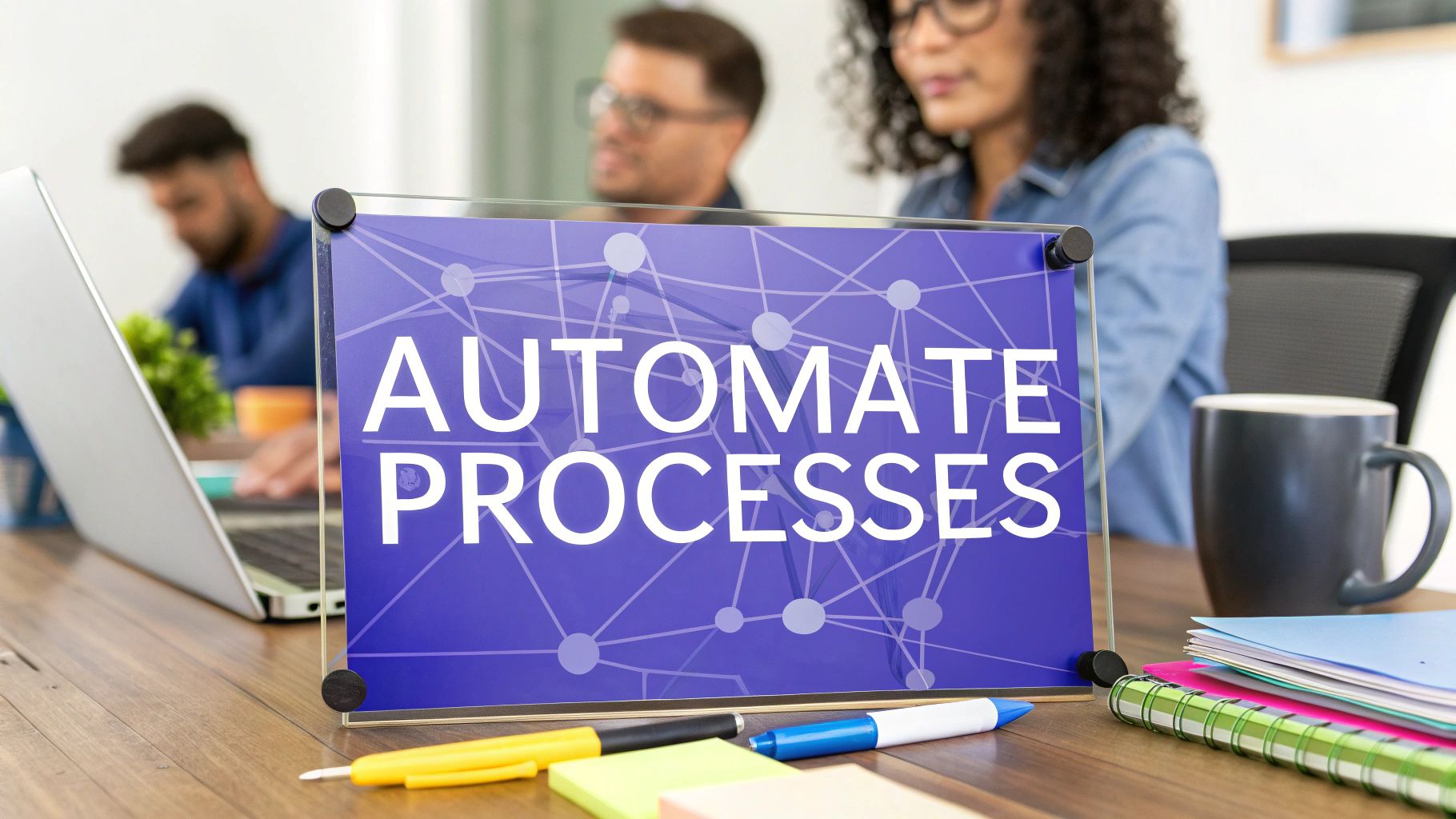8 Powerful AI Agent Use Cases for Teams in 2025
Discover 8 detailed AI agent use cases for sales, operations, and support teams. Learn how to implement AI agents to boost productivity and efficiency.

AI agents are fundamentally changing how businesses operate. They have moved beyond simple automation and now act as sophisticated systems capable of managing complex, multi-step tasks. For teams in sales, operations, development, and customer success, these tools are becoming central to maintaining a competitive edge. AI agents handle routine work, provide sharp analytical insights, and equip teams to make better, faster decisions. This shift allows skilled professionals to concentrate on strategic initiatives rather than getting bogged down by repetitive processes.
This article breaks down eight specific AI agent use cases that demonstrate how modern teams are transforming their daily workflows. We will explore practical, real-world examples, showing how platforms like Chatiant enable organizations to integrate this technology effectively. Instead of high-level theory, you will find a detailed analysis of each application, complete with strategic insights and actionable takeaways. The goal is to provide a clear blueprint you can adapt for your own team. We will cover everything from automating customer support and optimizing supply chains to detecting cybersecurity threats and personalizing marketing content. Each example is designed to offer a replicable strategy for achieving greater efficiency and impact in your specific role.
1. Customer Service and Support Agents
AI-powered customer service agents are autonomous systems designed to manage customer inquiries and resolve issues across various communication channels like chat, email, and voice. These agents use natural language processing (NLP) to interpret customer intent and deliver relevant, accurate responses in real time. They represent one of the most impactful ai agent use cases because they directly address core business needs: improving efficiency, reducing operational costs, and boosting customer satisfaction.
For instance, Zendesk's Answer Bot successfully automates responses to over 50% of routine inquiries, freeing up human agents to focus on more complex problems. Similarly, Bank of America's virtual assistant, Erica, assists millions of users with everyday banking tasks, demonstrating the scalability of these AI agents in a high-volume environment. The key is to start with a well-defined scope, such as frequently asked questions, before expanding the agent's capabilities.
Strategic Analysis
The primary strategy is to offload high-volume, low-complexity tasks from human support teams. This creates a tiered support system where AI handles the frontline, resolving common issues instantly. When a query becomes too difficult or requires a human touch, the agent seamlessly escalates the conversation, providing the human agent with full context. This hybrid model optimizes resource allocation and makes sure customers receive the best possible support, whether from an AI or a person.
Key Insight: Effective AI support is about augmenting human agents, not replacing them. The goal is to create a frictionless experience where AI resolves simple issues instantly, allowing human experts to dedicate their time to high-value interactions that require empathy and nuanced problem-solving.
Actionable Takeaways
To implement this effectively, organizations should:
- Start with FAQs: Build the agent’s knowledge base around your most common customer questions for immediate impact.
- Design Clear Escalation Paths: Create a simple, reliable process for customers to connect with a human agent at any point.
- Monitor and Refine: Continuously analyze conversation logs to identify areas for improvement and update the AI’s response accuracy.
This infographic summarizes the core benefits that make AI agents so valuable for modern support teams.
The data highlights a significant operational advantage: AI provides instant, 24/7 support globally and is projected to become the primary channel for customer interactions. To get started building an effective AI-driven support system, you can learn more about an AI-powered help desk and its capabilities.
2. Personal Assistant and Productivity Agents
AI personal assistants are autonomous agents designed to help individuals manage daily tasks, organize schedules, and streamline productivity workflows. These agents use machine learning to understand user habits and preferences, allowing them to proactively organize emails, schedule meetings, and automate routine actions. This is one of the most widely adopted ai agent use cases, as it directly improves individual and team efficiency by reclaiming time spent on administrative busywork.
For example, Google Assistant and Apple's Siri manage schedules and smart home devices for millions of users, while specialized tools like x.ai’s Amy fully automate the difficult back-and-forth of meeting scheduling. Similarly, Notion AI assists with organizing project documents and generating content, showcasing how these agents can integrate directly into professional workflows to boost output. For individuals and teams looking to streamline daily tasks, a comprehensive guide to AI personal assistants can offer valuable insights into their capabilities.
Strategic Analysis
The core strategy is to delegate repetitive, time-consuming administrative tasks to an AI agent, freeing up cognitive resources for more strategic work. The agent acts as a digital executive assistant, handling everything from calendar management to information retrieval. When an agent can manage meeting logistics, it allows professionals to focus on preparing for the meeting itself. This approach significantly reduces context-switching and mental overhead.
Key Insight: The true power of personal AI assistants is found in cognitive offloading, not just task automation. By handling the logistical details of the workday, these agents create uninterrupted blocks of time for focused work and creative problem-solving, which are far more valuable activities.
Actionable Takeaways
To implement this effectively, organizations and individuals should:
- Start with Scheduling: Begin by automating a single, high-frequency task like meeting scheduling to see an immediate return on investment.
- Integrate with Core Tools: Connect the AI agent to your primary calendar, email, and project management applications for seamless operation.
- Set Clear Permissions: Define the boundaries for automated actions, making sure the agent only operates within a comfortable and secure scope.
By offloading scheduling, you can recover significant portions of your workday. To explore this further, you can learn more about how an AI meeting scheduler works.
3. Financial Trading and Investment Agents
Financial trading and investment agents are sophisticated AI systems designed to analyze market data, execute trades, and manage investment portfolios automatically. These agents use complex machine learning algorithms to identify market patterns, assess risk, and make split-second decisions based on vast datasets. This application is one of the most advanced ai agent use cases, showcasing how automation can operate in high-stakes, data-intensive environments where speed and accuracy are paramount.
For example, Renaissance Technologies' Medallion Fund uses AI to achieve consistently high returns, while JPMorgan’s LOXM algorithm optimizes trade execution for institutional clients. On the consumer side, robo-advisors like Betterment and Wealthfront use AI agents to build and manage diversified portfolios for retail investors, making sophisticated investment strategies more accessible.
Strategic Analysis
The core strategy is to leverage computational power to outperform human traders in speed and data processing capacity. These AI agents can analyze millions of data points, from price movements to news sentiment, in milliseconds to identify profitable opportunities. They operate 24/7 without emotional bias, systematically executing strategies that would be impossible for a human to manage. The system is designed to exploit market inefficiencies and optimize for specific risk-return profiles.
Key Insight: AI's real advantage in finance is its ability to operate on a scale and speed that surpasses human capability. It is not just about making better predictions; it is about executing a statistically superior strategy relentlessly and without fatigue or fear, capitalizing on fleeting market opportunities.
Actionable Takeaways
To implement this effectively, organizations should:
- Implement Robust Risk Management: Integrate strict circuit breakers and risk controls to prevent catastrophic losses during unexpected market volatility.
- Backtest Rigorously: Continuously test and validate algorithms against historical data to confirm they perform as expected under various market conditions.
- Maintain Human Oversight: Keep a human expert in the loop to intervene during unprecedented events or when an agent’s behavior deviates from its intended strategy.
4. Healthcare Diagnosis and Treatment Agents
AI agents in healthcare are sophisticated systems designed to assist medical professionals with diagnosing diseases, recommending treatments, and monitoring patient health. These agents process vast amounts of data, including medical images, electronic health records, and clinical literature, to identify patterns and provide evidence-based insights. This application is one of the most important ai agent use cases because it has the potential to dramatically improve diagnostic accuracy, personalize patient care, and accelerate medical research.
For example, Google's DeepMind can detect diabetic retinopathy in eye scans with accuracy comparable to human ophthalmologists. Similarly, PathAI's platform assists pathologists in identifying cancer cells more accurately and efficiently, reducing diagnostic errors. These agents are not meant to replace clinicians but to augment their expertise, providing a powerful second opinion grounded in data.
Strategic Analysis
The core strategy here is to leverage AI for data-intensive analysis that exceeds human capacity, enabling earlier and more accurate diagnoses. These agents can analyze a CT scan or pathology slide in seconds, flagging anomalies that a human might miss due to fatigue or high workload. This allows physicians to focus their attention on difficult cases and treatment planning. The agent acts as a diligent, tireless assistant, pre-analyzing information to streamline the clinical workflow.
Key Insight: Diagnostic AI agents are valuable because they augment, not automate, clinical judgment. Their purpose is to improve a physician's perception by highlighting subtle patterns in complex data, leading to better-informed decisions while keeping the human expert in control of patient care.
Actionable Takeaways
To integrate this technology responsibly, healthcare organizations should:
- Confirm Comprehensive Validation: Test and validate AI models across diverse patient populations to avoid bias and achieve equitable performance.
- Maintain Physician Oversight: Implement workflows that require a qualified medical professional to review AI-generated suggestions and make the final clinical decision.
- Prioritize Transparency: Choose or develop AI systems with explainable AI (XAI) capabilities so clinicians can understand the basis for a recommendation.
5. Autonomous Vehicle Navigation Agents
Autonomous vehicle navigation agents are sophisticated AI systems that pilot self-driving cars. They process immense amounts of sensor data from cameras, lidar, and radar to interpret road conditions, traffic patterns, and potential hazards. These agents use this data to make critical, real-time decisions, representing one of the most advanced ai agent use cases in the physical world. Their goal is to maintain passenger safety and provide efficient, autonomous transportation.

For instance, Waymo operates a fully autonomous ride-hailing service in Phoenix and San Francisco, showing the viability of these agents in complex urban settings. Tesla's Autopilot has accumulated billions of miles of real-world driving data, which is used to continuously train and improve its neural networks. Similarly, Cruise and Mercedes-Benz have deployed their own systems, demonstrating a clear industry-wide push toward autonomous mobility solutions.
Strategic Analysis
The core strategy is to create an AI decision-making engine that can perceive, predict, and act more reliably and quickly than a human driver. These agents integrate computer vision for object recognition, sensor fusion to build a 360-degree view, and deep learning models to anticipate the behavior of other road users. The system operates on a continuous loop of data collection, processing, and action, allowing it to navigate safely through dynamic environments.
Key Insight: The ultimate goal of autonomous navigation is to exceed human driving by eliminating human error. By processing more environmental data than a person ever could and responding with machine precision, these agents aim to create a safer, more efficient transportation system.
Actionable Takeaways
To develop and deploy this technology successfully, companies should:
- Implement Comprehensive Simulation: Use advanced simulation environments to test the AI agent against millions of scenarios, including rare and dangerous edge cases, before real-world deployment.
- Focus on Specific Use Cases: Start with controlled environments, like highway driving or geofenced urban areas, to prove reliability before expanding to more challenging conditions.
- Develop Robust Human-Machine Interfaces: Design clear and intuitive interfaces that keep the human driver informed about the vehicle's status and intentions, building trust and confirming a safe handover of control when needed.
This video from Waymo shows how their autonomous agents perceive and navigate the world.
The footage reveals the complexity of the agent's decision-making process, highlighting its ability to handle unpredictable city driving. For teams in related industries, understanding these systems offers a blueprint for building autonomous agents that interact with the physical world. You can explore more about Waymo's technology and its approach to safety on their official site.
6. Content Creation and Marketing Agents
Content creation and marketing agents are autonomous systems that generate, optimize, and distribute content across various channels. These agents use generative AI to produce written copy, design visuals, and personalize messaging at scale. They represent one of the most transformative ai agent use cases because they directly tackle the immense challenge of creating high-quality, relevant content consistently, which is fundamental to modern marketing.
For example, Jasper AI helps thousands of businesses generate on-brand marketing copy, from blog posts to ad headlines, drastically reducing production time. Similarly, Persado uses its AI to generate and test email subject lines that are optimized for emotional engagement, boosting open rates. These agents work by analyzing vast datasets to understand what content resonates with specific audiences, then applying those insights to create new, effective materials.
Strategic Analysis
The core strategy is to use AI agents to automate the most time-consuming aspects of content production and personalization. This allows marketing teams to scale their output without a proportional increase in headcount or budget. The agent acts as a creative assistant, handling first drafts, A/B testing variations of ad copy, or creating personalized email campaigns. Humans then step in for final review, strategic oversight, and adding a unique brand voice, shifting their focus from manual creation to high-level strategy and optimization.
Key Insight: AI's real power in content marketing is the ability to test and personalize at a scale humans cannot match. These agents can create hundreds of content variations and analyze performance data in real time to continuously improve engagement.
Actionable Takeaways
To implement this effectively, organizations should:
- Define Clear Brand Guidelines: Provide the AI with a detailed brand voice, style guide, and target audience personas to maintain content consistency.
- Implement Human Review: Use AI for ideation and first drafts, but always have a human editor review and refine the output for quality and accuracy.
- Optimize for AI Search: As search engines evolve, content must be adapted for new discovery methods. Learning how to approach Mastering AI Search Optimization is important for maintaining visibility.
7. Cybersecurity and Threat Detection Agents
AI-powered cybersecurity agents are autonomous systems built to monitor networks, detect threats, and respond to cyberattacks in real time. These agents use machine learning to analyze vast amounts of network traffic, user behavior, and system logs to identify anomalies and potential threats that human teams might miss. This application is one of the most important ai agent use cases because it addresses the escalating speed and sophistication of modern cyber threats, offering proactive defense instead of reactive cleanup.

For example, Darktrace’s Enterprise Immune System learns the "normal" behavior of a network and can spot subtle deviations that indicate an insider threat or a novel attack. Similarly, CrowdStrike Falcon leverages AI to provide endpoint protection by predicting and preventing malware executions before they can cause damage. These tools show how AI agents can operate at a scale and speed that is impossible for human analysts alone, providing a much-needed layer of defense.
Strategic Analysis
The core strategy is to use AI agents for continuous, autonomous surveillance and rapid threat neutralization. These systems establish a baseline of normal activity and then flag or block any behavior that deviates from it, such as unusual data access or network connections. This approach is highly effective against zero-day exploits and insider threats, which often bypass traditional signature-based security tools. When a credible threat is identified, the AI agent can automatically isolate affected systems to prevent the attack from spreading.
Key Insight: The primary advantage of AI in cybersecurity is its ability to move from a reactive to a predictive posture. Instead of just blocking known threats, AI agents identify the patterns of an impending attack, allowing security teams to neutralize it before it executes and causes significant damage.
Actionable Takeaways
To implement this security layer effectively, organizations should:
- Implement a Layered Approach: Use AI detection as part of a comprehensive security strategy that includes firewalls, antivirus, and employee training.
- Update Threat Intelligence: Regularly feed the AI agent with the latest threat intelligence data to keep its predictive models sharp and relevant.
- Establish Response Playbooks: Create clear incident response plans for how human teams should react when an AI agent flags a high-priority threat.
8. Supply Chain and Logistics Optimization Agents
AI agents for supply chain and logistics are autonomous systems designed to optimize operations, manage inventory, predict demand, and coordinate movements across complex networks. These agents process vast datasets in real time, including weather, traffic, supplier performance, and market conditions, to make optimal decisions that reduce costs and improve efficiency. This application is one of the most important ai agent use cases because it directly improves a business’s operational backbone, impacting everything from raw material sourcing to final delivery.
For example, UPS’s ORION (On-Road Integrated Optimization and Navigation) system uses AI to calculate the most efficient delivery routes for its drivers, saving the company millions of gallons of fuel and 100 million miles annually. Similarly, Amazon’s sophisticated AI manages its vast fulfillment network, predicting demand, positioning inventory, and optimizing millions of daily deliveries. These examples show how AI agents can manage immense operational complexity at scale.
Strategic Analysis
The core strategy is to use predictive and prescriptive analytics to move from a reactive to a proactive supply chain model. AI agents analyze historical and real-time data to forecast demand, identify potential bottlenecks, and suggest optimal inventory levels. When disruptions occur, such as a supplier delay or a sudden weather event, the agent can autonomously reroute shipments or adjust production schedules to minimize impact. This creates a resilient, self-optimizing system that constantly adapts to changing conditions.
Key Insight: The goal is to create an intelligent, interconnected supply chain, not just to automate logistics tasks. AI agents serve as the central nervous system, processing signals from thousands of sources to make holistic decisions that improve efficiency, reduce waste, and improve delivery speed.
Actionable Takeaways
To effectively implement this, organizations should:
- Start with Pilot Projects: Test AI optimization on specific product lines or in limited geographic regions to validate its effectiveness before a full-scale rollout.
- Confirm Data Quality: Integrate and cleanse data from all relevant systems (ERP, WMS, TMS) to provide the AI with a clean, comprehensive dataset.
- Maintain Human Oversight: Keep human experts in the loop for strategic decision-making and to manage exceptions or unprecedented disruptions the AI cannot handle.
By focusing on these areas, companies can build a more responsive and efficient supply chain. To see how this fits into a broader strategy, you can find more information about how this is a great example of business process automation.
AI Agent Use Cases Comparison Matrix
Putting AI Agents to Work in Your Business
The diverse ai agent use cases we have explored, from managing customer support tickets to optimizing complex supply chains, reveal a powerful common thread. Success is not found in a broad, undefined push for "AI adoption." Instead, it stems from a focused strategy: identifying specific, high-value business challenges and applying targeted AI agents to solve them. This approach allows teams to augment their existing skills, not replace them, leading to measurable improvements in efficiency and output.
For a sales team, this means an AI agent can handle initial lead qualification and data entry, freeing up representatives to focus on building relationships and closing deals. Operations teams can deploy agents to monitor inventory levels and predict demand, preventing stockouts and reducing waste. The key is to see AI agents as specialized tools designed to perform discrete tasks with high precision.
From Theory to Practical Application
The journey from understanding these concepts to implementing them can seem significant, but the path forward is clear. The most effective strategies begin with a small, manageable pilot project.
- Identify a Bottleneck: Where does your team spend the most time on repetitive, low-impact work? This could be answering the same customer questions, manually updating a CRM, or searching for information across multiple systems.
- Define a Specific Task: Frame the problem as a clear task for an AI agent. For example, "Create an agent that can instantly retrieve a customer's order history from our database when prompted in Slack."
- Measure and Iterate: Track the agent's performance. How much time did it save? Did it reduce errors? Use this data to refine the agent and identify the next high-impact task to automate.
This iterative process demystifies AI and builds internal confidence. It allows your teams to see direct benefits and become active participants in finding new, valuable ai agent use cases that are unique to your business operations.
The Future is Augmented, Not Replaced
The true potential of AI agents is unlocked when they function as a seamless extension of your team. By handling the logistical and data-intensive work, these agents create the space for human creativity, strategic thinking, and genuine connection to flourish. Your developers can spend less time on routine bug reporting and more time innovating. Your customer success managers can build deeper client relationships instead of just closing tickets.
Mastering the deployment of AI agents is more than a technical exercise; it is a strategic advantage. It builds a more resilient, efficient, and intelligent organization prepared for future challenges. The practical examples show that this technology is no longer a distant concept but a present-day tool ready to be configured and put to work. The companies that learn to integrate these agents effectively will be the ones that lead their industries.
Ready to move from theory to action? Chatiant provides a powerful platform to build and deploy the exact ai agent use cases discussed in this article, trained on your company's data and integrated with the tools you already use. Start building your custom AI agents today and see how they can transform your team's productivity.


